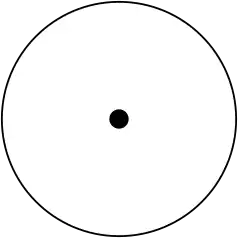Monad (philosophy)
Monad (from Greek μονάς monas, "singularity" in turn from μόνος monos, "alone")[1] refers, in cosmogony, to the Supreme Being, divinity or the totality of all things. The concept was reportedly conceived by the Pythagoreans and may refer variously to a single source acting alone, or to an indivisible origin, or to both. The concept was later adopted by other philosophers, such as Gottfried Wilhelm Leibniz, who referred to the monad as an elementary particle. It had a geometric counterpart, which was debated and discussed contemporaneously by the same groups of people.

| Part of a series on |
| God |
|---|
Historical background
According to Hippolytus, the worldview was inspired by the Pythagoreans, who called the first thing that came into existence the "monad", which begat (bore) the dyad (from the Greek word for two), which begat the numbers, which begat the point, begetting lines or finiteness, etc.[2] It meant divinity, the first being, or the totality of all beings, referring in cosmogony (creation theories) variously to source acting alone and/or an indivisible origin and equivalent comparators.[3]
Pythagorean and Platonic philosophers like Plotinus and Porphyry condemned Gnosticism (see Neoplatonism and Gnosticism) for its treatment of the monad.
In his Latin threaty Maximae theologiae, Alan of Lille affirms "God is an intelligible sphere, whose center is everywhere and whose center is nowhere." The French philosopher Rabelais ascribed this proposition to Hermes Trismegistus.[4]
The symbolism is a free exegesis related to the Christian Most Holy Trinity.[4] Alan of Lille mentions the Trismegistus'Book of the Twenty-Four Philosophers where it says a Monad can uniquely engender another Monad in which more followers of this religion saw the come to being of God the Son from God the Father, both by way of generation or by way of creation.[4] This statement is also shared by the pagan author of the Asclepius[4] which sometimes has been identified with Trismegistus.
The Book of the Twenty-Four Philosophers completes the scheme adding that the ardor of the second Monad to the first Monad would be the Holy Ghost.[4] It closes a physical circle in a logical triangle (with a retroaction).
The Euclidean symbolism of the centered sphere also concerns the secular debate on the existence of a center of the universe.
Pythagorean concept
For the Pythagoreans, the generation of number series was related to objects of geometry as well as cosmogony.[5] According to Diogenes Laërtius, from the monad evolved the dyad; from it numbers; from numbers, points; then lines, two-dimensional entities, three-dimensional entities, bodies, culminating in the four elements earth, water, fire and air, from which the rest of our world is built up.[6][7]
Modern philosophy
The term monad was adopted from Greek philosophy by modern philosophers Giordano Bruno, Anne Conway, Gottfried Wilhelm Leibniz (Monadology), John Dee, and others.
See also
Notes
- Compact Editions of the Oxford English Dictionary.
- Diogenes Laërtius, Lives and Opinions of Eminent Philosophers.
- Fairbanks, Arthur, Ed., "The First Philosophers of Greece". K. Paul, Trench, Trubner. London, 1898, p. 145.
- Gilson, Etienne (February 15, 2019). "From Scotus Eriugena to Saint Bernard". History of Christian Philosophy in the Middle Ages. Washington DC: Catholic University of America Press. p. 174,809. ISBN 9780813231952. OCLC 1080547285.
- Sandywell, p. 205. The generation of the series of number is to the Pythagoreans, in other words, both the generation of the objects of geometry and also cosmogony. Since things equal numbers, the first unit, in generating the number series, is generating also the physical universe. (KR: 256) From this perspective ‘the monad’ or ‘One’ was readily identified with the divine origin of reality.
- Diogenes Laërtius, Lives of Eminent Philosophers.
- This Pythagorean cosmogony is in some sense similar to a brief passage found in the Daoist Laozi: "From the Dao comes one, from one comes two, from two comes three, and from three comes the ten thousand things".(道生一、一生二、二生三、三生萬物。)Dao De Jing, Chapter 42
References
- Hemenway, Priya. Divine Proportion: Phi In Art, Nature, and Science. Sterling Publishing Company Inc., 2005, p. 56. ISBN 1-4027-3522-7
- Sandywell, Barry. Presocratic Reflexivity: The Construction of Philosophical Discourse C. 600-450 BC. Routledge, 1996.